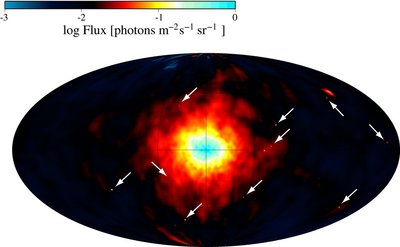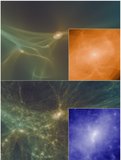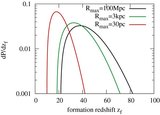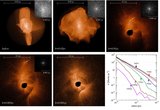Image Details

Caption: Figure 5.
All-sky map of the gamma-ray annihilation signal of our Galaxy. Pointlike sources indicated by arrows show the contributions
from microhalos less than 1 pc from the observer and with flux larger than 0.03 photons m
−2 s
−1 sr
−1. Here, we assume that the number of photons per annihilation is
N
γ = 30, the interaction cross section of dark matter is
![]() σ
v
σ
v
![]() = 3.0 × 10
−26 cm
3 s
-1, and the mass of dark matter particle is
m
χ = 100 GeV. The flux of the integrated emission of microhalos in the galactic center is 1.40 photons m
−2 s
−1 sr
−1. The flux of the most brightest microhalo is 0.069 photons m
−2 s
−1 sr
−1. The flux needed for a 10σ detection for
Fermi is ~0.4 × 10
−6 photons cm
−2 s
−1 for low Galactic latitude and is ~0.1 × 10
−6 photons cm
−2 s
−1 for high Galactic latitude (Abdo et al. 2009a). The angular resolution of
Fermi is about 0.1 deg for energies above 1 GeV.
= 3.0 × 10
−26 cm
3 s
-1, and the mass of dark matter particle is
m
χ = 100 GeV. The flux of the integrated emission of microhalos in the galactic center is 1.40 photons m
−2 s
−1 sr
−1. The flux of the most brightest microhalo is 0.069 photons m
−2 s
−1 sr
−1. The flux needed for a 10σ detection for
Fermi is ~0.4 × 10
−6 photons cm
−2 s
−1 for low Galactic latitude and is ~0.1 × 10
−6 photons cm
−2 s
−1 for high Galactic latitude (Abdo et al. 2009a). The angular resolution of
Fermi is about 0.1 deg for energies above 1 GeV.
Copyright and Terms & Conditions
© 2010. The American Astronomical Society. All rights reserved.







